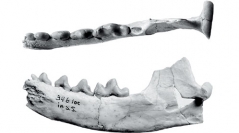

 Geodiversitas
31 (4) - Pages 743-751
Geodiversitas
31 (4) - Pages 743-751The Tunggur Formation in Inner Mongolia has produced a well-known middle Miocene Platybelodon fauna; this fauna has provided some evidence of intercontinental exchanges of carnivoran taxa during that time. Here we describe a new immigrant mustelid from the Tunggur Formation. The new material, composed of two partial dentaries, belongs to the genus Sthenictis. A new species, S. neimengguensis n. sp., is named after the dentaries which represent the first occurrence of this genus outside North America. Sthenictis neimengguensis n. sp. is closest in size and morphology to the North American S. dolichops, but the former has a more slender dentition and mandible. In terms of carnassial morphology, the less trenchant m1 talonid and a well-developed m1 metaconid in S. neimengguensis n. sp. are plesiomorphic characters of the Mustelinae. The relatively elongated tooth row and simple premolar morphology, however, unites it with other species of Sthenictis. This combination of characters excludes Sthenictis from both the highly hypercarnivorous Hoplictis-Ischyrictis-Eomellivora group and Iberictis-Plesiogulo group, and seems to represent that of a basal lineage with intermediate morphology.
Mammalia, Carnivora, Mustelidae, Old World, China, Inner Mongolia, middle Miocene, Tunggur Formation, new species